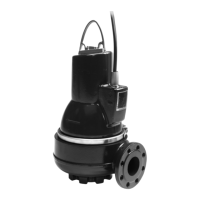English (GB)
25
9. Startup
9.1 General startup procedure
This procedure applies to new installations as well
as after service inspections if startup takes place
some time after the pump was placed in the tank.
1. Remove the fuses and check that the impeller
can rotate freely. Turn the impeller by hand.
2. Check the condition of the oil in the oil chamber.
See also section 10.1 Inspection.
3. Check that the system, bolts, gaskets, pipes and
valves are in correct condition.
4. Mount the pump in the system.
5. Switch on the power supply.
6. Check whether the monitoring units, if used, are
operating satisfactorily.
7. For pumps with WIO sensor, switch on IO 113
and check that there are no alarms or warnings.
See section 8.6 IO 113.
8. Check the setting of air bells, float switches or
electrodes.
9. Check the direction of rotation. See section
9.3 Direction of rotation.
10. Open the isolating valves, if fitted.
11. Check that the liquid level is above the motor for
S1 operation and above the cable entry for S3
operation. See fig. 14. If the minimum level is not
reached do not start the pump.
12. Start the pump and let the pump run briefly, and
check if the liquid level is falling.
13. Observe if the outlet pressure and input current
are normal. If not there might be air trapped
inside the pump.
After one week of operation or after replacement of
the shaft seal, check the condition of the oil in the
chamber. For pumps without sensor, this is done by
taking a sample of the oil. See section
10. Maintenance and service for procedure.
Every time the pump has been removed from the
tank, go through the above procedure when starting
up again.
9.2 Operating modes
The pumps are designed for intermittent operation
(S3). When completely submerged, the pumps can
also operate continuously (S1).
S3, intermittent operation:
Operating mode S3 means that within 10 minutes the
pump must be in operation for 4 minutes and
stopped for 6 minutes. See fig. 12.
In this operating mode, the pump is partly
submerged in the pumped liquid, that is the liquid
level reaches at minimum the top of the cable entry
on the motor housing. See fig. 2.
Fig. 12 S3, intermittent operation
DANGER
Electric shock
Death or serious personal injury
- Before starting work on the pump, make
sure that the fuses have been removed
or the main switch has been switched
off. Make sure that the power supply
cannot be accidentally switched on.
Make sure that all protective equipment
has been connected correctly. The
pump must not run dry.
The pump must not be started if the
atmosphere in the tank is potentially
explosive.
DANGER
Crushing of hands
Death or serious personal injury
- It may lead to personal injuries or death
to open the clamp while the pump is
operating.
CAUTION
Sharp element
Minor or moderate personal injury
- The impeller can have sharp edges -
wear protective gloves.
Check that there is positive inlet pressure
before starting up the pump.
Trapped air can be removed from the
pump housing by tilting the pump by
means of the lifting chain when the pump
is in operation.
In case of abnormal noise or vibrations
from the pump, other pump failure or
power supply failure or water supply
failure, stop the pump immediately. Do not
attempt to restart the pump until the cause
of the fault has been found and the fault
corrected.
TM04 4527 1509
Operation
Stop
6 min.4 min.
10 min.
P
t

